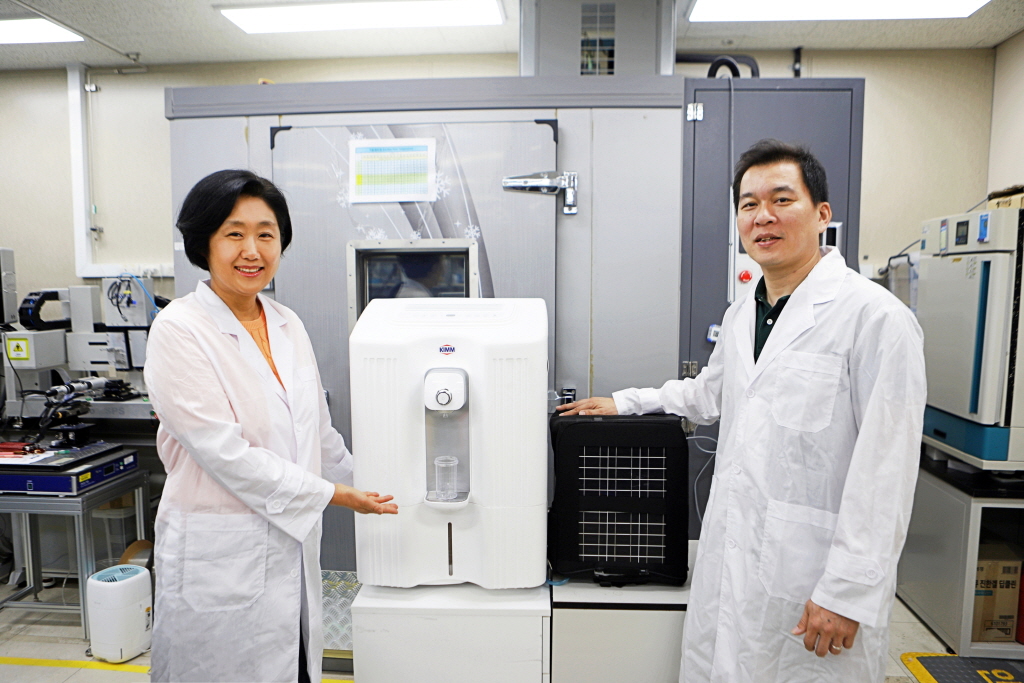동·식물 메커니즘에서 착안한 친환경적 기술로 공기 중 수분을 모아 살균해 먹는 물을 생산하는 ‘휴대용 수분 포집 시스템’이 국내 최초로 개발됐다. 향후 군용, 캠핑용, 도서 산간 지역 생존수 생산 시스템 등 다양한 분야의 원천기술에 활용될 것으로 기대된다.

▲기계연 자연모사연구단 임현의 연구단장과 오선종 책임연구원이 개발한 ‘휴대용 수분 포집 시스템’과 함께 사진촬영을 하고 있다.
기계연, ‘휴대용 수분 포집 시스템’ 개발
동·식물 메커니즘에서 착안한 친환경적 기술로 공기 중 수분을 모아 살균해 먹는 물을 생산하는 ‘휴대용 수분 포집 시스템’이 국내 최초로 개발됐다. 향후 군용, 캠핑용, 도서 산간 지역 생존수 생산 시스템 등 다양한 분야의 원천기술에 활용될 것으로 기대된다.
한국기계연구원(원장 류석현) 임현의 연구단장 연구팀은 독자 개발한 ‘휴대용 수분 포집 시스템’을 이용한 약 3kg 물 수확기 상용화를 앞두고 있다고 20일 밝혔다.
물 수확 성능과 먹는 물 안정성 검증 등 공인인증기관 성적서를 통해 인증 받았으며, ㈜퓨어시스에 기술이전해 휴대용부터 대용량까지 다양한 제품군 사업화를 계획하고 있다.
연구팀이 개발한 ‘휴대용 수분 포집 시스템’은 ‘흡착→탈착→응축→살균’ 수분 포집 사이클을 원천기술로 하며, 포집량을 크게 늘렸다.
기존 제습 시스템 대비 2배 이상 에너지 효율이 개선됐다.
또한 수분이 응축되는 냉각핀을 순간 80℃까지 가열해 표면의 박테리아를 1분 내 살균하고 자연 분해가 가능한 친환경 필터로 정수하는 등 안정성을 검증받았다.
기존 ‘수분 포집 시스템’은 냉각식 제습기와 에어컨 같이 수분 과포화 상태를 조절하기 위한 응축기, 증발기, 압축기 등으로 구성되어 소음, 무게, 냉매 사용에 따른 환경오염의 우려가 있다.
이러한 문제를 개선하기 위해 열전소자를 이용한 수분 포집 시스템이 개발되고 있지만, 압축기를 사용하는 컴프레셔 타입에 비해 수분 포집의 에너지 효율이 크게 떨어지는 단점이 있다.
연구팀이 개발한 ‘휴대용 수분 포집 시스템’은 기존 열전소자 방식에 비해 2배 이상 포집 능력이 뛰어나다.
열전소자의 발열면을 흡습판으로 이용한 것이 핵심이다. 흡습판의 흡착 모드에서 공기 중 수분을 모으고, 발열모드에서 수분을 응축판으로 전달하는 방식으로 수분 포집 효율을 높였다.
또한 발열면에서 발생하는 고온의 열 에너지가 수분 탈착 시 사용되어 발열면에 의해 발생하는 뜨거운 공기 배출을 줄였다.
포집 능력과 함께 소비 전력도 우수하다. 연구팀은 수분 흡착 과정에서 열전소자에 전력 인가 없이 제습이 가능하도록 설계했다.
하나의 열전 모듈로 수분 흡착, 응축, 살균 모드를 실행할 수 있게 개발하여 소비 전력을 줄일 수 있었다. 규조토와 생분해 고분자로 자연 분해가 가능한 친환경 필터를 만들어 중금속은 물론 나노 크기의 미세플라스틱까지 제거할 수 있는 정수 시스템도 구축했다.
기계연 임현의 연구단장은 “물이 부족한 상황에서 식수를 확보할 수 있는 의미 있는 개발”이라며 “식수 부족, 가뭄 등 해결을 위해 세계 각국의 많은 사람이 안전하게 먹을 수 있는 음용수 생산 시스템 구축에 노력하겠다”고 말했다.
기계연 오선종 책임연구원은 “수분 포집 시스템은 기존 응축시스템이나 흡습 시스템의 원리를 복합해 사용하는 하이브리드 시스템”이라며 “에너지 사용량을 최소화하고 친환경 재료를 활용하는 지속가능형 기술”이라고 밝혔다.
이번 연구는 환경부 한국환경산업기술원 생태모방 기반 환경오염관리 기술개발사업 ‘생태모방 휴대용 물 수확기 개발’ 과제의 지원을 받아 수행됐다.
